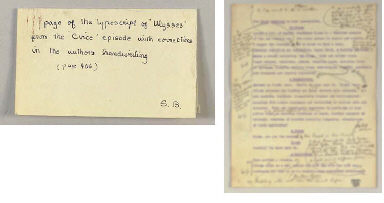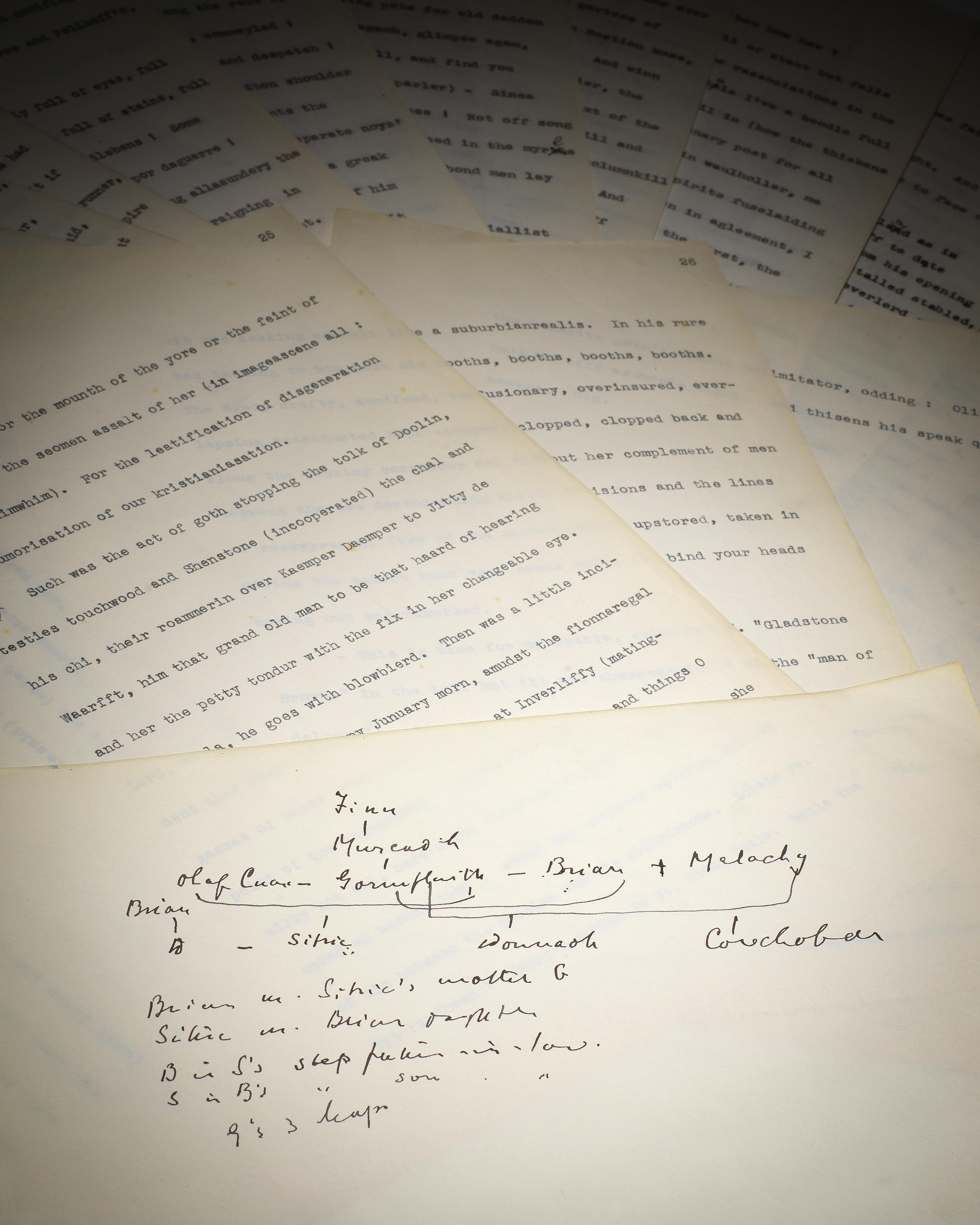JOYCE, James. Typescript carbon page from the "Circe" episode of "Ulysses," WITH HOLOGRAPH ADDITIONS IN JOYCE'S HAND, comprising 39 words of additional dialogue; one of the interpolated passages with a single word ("see") deleted by Joyce and replaced with "take a snapshot of," the leaf with stamped foliation "115" at top right-hand corner, alternate foliation "113" in bold pencil (by Joyce's?) at lower left-hand corner. [Paris, circa 1921]. 1 page, 269 x 208mm., carbon typescript on thin, tan typing paper, two small punctures at right-hand margin where sheets were once fastened together, a tiny chip missing from lower right-hand corner, uniformly browned (as is the case with all the leaves on this rather poor-quality paper). "RIDE A COCK HORSE": JOYCE AT WORK ON THE "CIRCE" EPISODE The work which became Ulysses was originally conceived as an additional story to be added to Dubliners ; Joyce stated that the actual writing was begun in Rome in about 1909-10, although no manuscripts earlier than about 1916 are extant. Ezra Pound had introduced Joyce to Harriet Shaw Weaver, editor of The Egoist , published in London, and in 1919 the first serial installments were published there. Pound also helped arrange for serial publication in America, in The Little Review , published in New York under the direction of Margaret Anderson and Jane Heap. Between September 1917 and 29 October 1921, when Joyce announced, prematurely, in a letter to Claud Sykes that Ulysses was finished, Joyce's working routine involved the use of different typists to prepare a top copy and at least two carbons; and "it was his habit to correct two of them extensively, but to leave the third aside with only its initial revisions" (B. Arnold, The Scandal of Ulysses , p.14). Joyce freely intermingled the top copies with the two carbons. It was apparently Joyce's intention that Ulysses would eventually be published in book form by the same two publishers who had undertaken its serial publication; these typescripts, it was thought, would serve each set of printers with setting copy. In the end, of course, serial publication was abandoned due to legal battles in both American and English courts. At this point, when obstacles to its publication seemed insurmountable, Sylvia Beach, proprietor of the Left Bank bookshop, stepped in. As she relates "...Here in my little bookshop sat James Joyce, sighing deeply. It occurred to me that something might be done, and I asked: 'Would you let Shakespeare and Company have the honor of bringing out your Ulysses?' He accepted my offer immediately and joyfully..." ( Shakespeare and Company , p.56). The present leaf is from the final typescript used by Beach's printer, Darantiere, to set type for the first proofs; all but a few stray leaves (like the present) are now in the Joyce Collection of the State University of New York at Buffalo (see Peter Spielberg, James Joyce's Manuscripts and Letters at the University of Buffalo: A Catalogue , V.B.13.h, pp.66-67). Most of the leaves in that typescript bear very slight corrections, usually of incidentals; some exhibit only a few changes in punctuation or strengthening of letters, and very few boast more than a word or two added by Joyce (It may be the extensive autograph changes that prompted this leaf to be selected from the typescript, probably as a gift by Sylvia Beach, who kept the printers' typescript.) The leaf shows Joyce making highly interesting additions to the portion of the "Circe" episode between Leopold Bloom, Boylan (Molly Bloom's lover) and the night-town whores. In the passage, Bloom, who has been reduced to a fawning servant in his own home, conducts Boylan in the door and up to Madame Tweedy (Molly Bloom), who luxuriates in her bath. She urges Boylan to let Bloom watch their coupling; Boylan agrees to let him peep through the keyhole "and play with yourself" (Joyce's ink addition). Bloom thanks him, humbly, asking "May I bring two men chums to take a snapshot?" (Joyce's
JOYCE, James. Typescript carbon page from the "Circe" episode of "Ulysses," WITH HOLOGRAPH ADDITIONS IN JOYCE'S HAND, comprising 39 words of additional dialogue; one of the interpolated passages with a single word ("see") deleted by Joyce and replaced with "take a snapshot of," the leaf with stamped foliation "115" at top right-hand corner, alternate foliation "113" in bold pencil (by Joyce's?) at lower left-hand corner. [Paris, circa 1921]. 1 page, 269 x 208mm., carbon typescript on thin, tan typing paper, two small punctures at right-hand margin where sheets were once fastened together, a tiny chip missing from lower right-hand corner, uniformly browned (as is the case with all the leaves on this rather poor-quality paper). "RIDE A COCK HORSE": JOYCE AT WORK ON THE "CIRCE" EPISODE The work which became Ulysses was originally conceived as an additional story to be added to Dubliners ; Joyce stated that the actual writing was begun in Rome in about 1909-10, although no manuscripts earlier than about 1916 are extant. Ezra Pound had introduced Joyce to Harriet Shaw Weaver, editor of The Egoist , published in London, and in 1919 the first serial installments were published there. Pound also helped arrange for serial publication in America, in The Little Review , published in New York under the direction of Margaret Anderson and Jane Heap. Between September 1917 and 29 October 1921, when Joyce announced, prematurely, in a letter to Claud Sykes that Ulysses was finished, Joyce's working routine involved the use of different typists to prepare a top copy and at least two carbons; and "it was his habit to correct two of them extensively, but to leave the third aside with only its initial revisions" (B. Arnold, The Scandal of Ulysses , p.14). Joyce freely intermingled the top copies with the two carbons. It was apparently Joyce's intention that Ulysses would eventually be published in book form by the same two publishers who had undertaken its serial publication; these typescripts, it was thought, would serve each set of printers with setting copy. In the end, of course, serial publication was abandoned due to legal battles in both American and English courts. At this point, when obstacles to its publication seemed insurmountable, Sylvia Beach, proprietor of the Left Bank bookshop, stepped in. As she relates "...Here in my little bookshop sat James Joyce, sighing deeply. It occurred to me that something might be done, and I asked: 'Would you let Shakespeare and Company have the honor of bringing out your Ulysses?' He accepted my offer immediately and joyfully..." ( Shakespeare and Company , p.56). The present leaf is from the final typescript used by Beach's printer, Darantiere, to set type for the first proofs; all but a few stray leaves (like the present) are now in the Joyce Collection of the State University of New York at Buffalo (see Peter Spielberg, James Joyce's Manuscripts and Letters at the University of Buffalo: A Catalogue , V.B.13.h, pp.66-67). Most of the leaves in that typescript bear very slight corrections, usually of incidentals; some exhibit only a few changes in punctuation or strengthening of letters, and very few boast more than a word or two added by Joyce (It may be the extensive autograph changes that prompted this leaf to be selected from the typescript, probably as a gift by Sylvia Beach, who kept the printers' typescript.) The leaf shows Joyce making highly interesting additions to the portion of the "Circe" episode between Leopold Bloom, Boylan (Molly Bloom's lover) and the night-town whores. In the passage, Bloom, who has been reduced to a fawning servant in his own home, conducts Boylan in the door and up to Madame Tweedy (Molly Bloom), who luxuriates in her bath. She urges Boylan to let Bloom watch their coupling; Boylan agrees to let him peep through the keyhole "and play with yourself" (Joyce's ink addition). Bloom thanks him, humbly, asking "May I bring two men chums to take a snapshot?" (Joyce's







Testen Sie LotSearch und seine Premium-Features 7 Tage - ohne Kosten!
Lassen Sie sich automatisch über neue Objekte in kommenden Auktionen benachrichtigen.
Suchauftrag anlegen